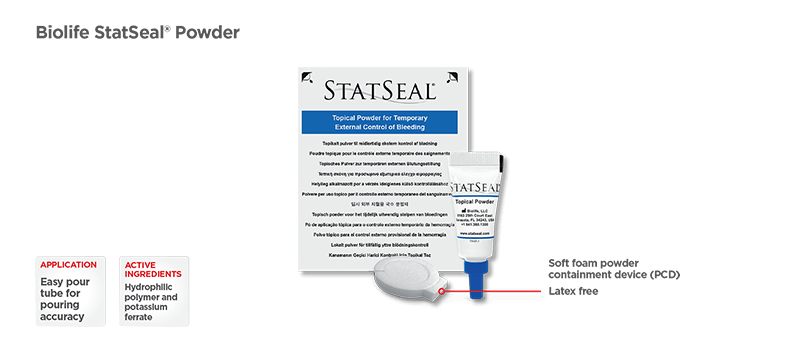
Biolife StatSeal® Powder
For the temporary external control of bleeding from wounds and procedures. Integrating StatSeal® into IR lab protocols results in significant clinical, economic and operational efficiencies. 1-5

For the temporary external control of bleeding from wounds and procedures. Integrating StatSeal® into IR lab protocols results in significant clinical, economic and operational efficiencies. 1-5

As an adjunct to pressure, StatSeal ® products have a two-step mechanism of action that occurs simultaneously to instantly form a low pH, occlusive seal.
The hydrophilic polymer rapidly dehydrates the blood and absorbs exudate, stacking up desiccated blood solids beneath to form a seal.
The potassium ferrate binds the blood solids and proteins together, adhering the seal to the wound to stop bleeding and oozing.
Beneath the seal, the pH is neutral, and the blood solids and proteins continue to stack. Above the seal, the hydrophilic polymer exchanges protons for cations, resulting in desiccation and a pH of ~2. The distal tract seal helps promote statsis at the arteriotomy.6
References: [1] Safirstein JG, Tehrani DM, Schussler JM, et al. Radial Hemostasis Is Facilitated With a Potassium Ferrate Hemostatic Patch: The STAT2 Trial. JACC Cardiovasc Interv. 2022 Apr 25;15(8):810-819. [2] GaluskoV, Protty M, Bharucha A,et al. TCT-781 The Quest for a Radial Lounge: StatSealReduces Transradial Coronary Angiography Turn-Around Time and Cost. JACC Suppl B. 2019; 24(13)B765. [3] Khuddus M, Ayyaz Ul Haq M, Massaro J, et al Meta-Analysis of Radial Hemostasis Trials Using Patent Hemostasis and a Potassium Ferrate Hemostatic Disc. Poster presented at: Thirty-first Annual symposium Transcatheter Cardiovascular Therapeutics (TCT); September, 2019; San Diego, CA. [4] De Korompay N, Klass D, Chung J, et al. Safety and efficacy of a rapid deflation algorithm for patent hemostasis following radial intervention (PROTEA. In: Proceedings from the Society of Interventional Radiology; March 4-9, 2017; Washington DC. Abstract 301. [5] Wang DS, Chu LF, Olson SE, et al. Comparative evaluation of noninvasive compression adjuncts for hemostasis in percutaneous arterial, venous, and arteriovenous dialysis access procedures. J Vasc Interv Radiol. 2008 Jan;19(1):72-9. [6] Alaya M. PICC Insertion Dressing Protocol for the Hematologocal Oncology Patient: A Comparison of Biopatchand StatSeal. Poster presented at AVA Annual Meeting October 4-7, 2019; Las Vegas, NV. [7] Wilder KA, Wall B, Haggard D, et al. CLABSI Reduction Strategy: A Systemic Central Line Quality Improvement Initiative Integrating Line-Rounding Principles and a Team Approach. Adv Neonatal Care. 2016 Jun;16(3):170-7. [8] Blough L, Hinson K, Hen J. The science of a seal for PICC line management: bio seal CVC powder. J VAS Access. 2010;15(2):66-73. [9] Biolife, LLC, 510(k) K080210, Section 18.3.